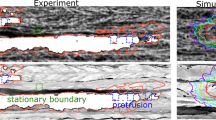Abstract
A two-dimensional cellular automata model was developed to describe the static recrystallization (SRX) arising from the subgrain growth, the driving force of which is dependent on boundary energy and local curvature. At the same time, the subgrain boundary energy and mobility rely on the boundary misorientation angle. On the basis, a deterministic switch rule was adopted to simulate the subgrain growth and kinetics of recrystallization quantitatively to provide an insight into the grain boundary bulging nucleation mechanism. Microstructure evolutions during SRX in different cases were simulated by the developed model. At the beginning of the simulation, the initial polycrystalline microstructure which contains large number of uniformly distributed subgrains in every pre-existing grain was prepared using simple assumption based on experimental observations. Then, both homogeneous and inhomogeneous subgrain growth phenomena were captured by the simulation with different inter-subgrain misorientation, which showed continuous and discontinuous recrystallization, respectively. The effects of initial mean subgrain radius, distribution of initial subgrains, distribution of inter-subgrain misorientations, and annealing temperature on the recrystallization kinetics were also investigated.














Similar content being viewed by others
References
Humphreys FJ, Hatherly M (2004) Recrystallization and related annealing phenomena. Pergamon Press, Oxford
Holm EA, Miodownik MA, Rollett AD (2003) Acta Mater 51:2701
Radhakrishnan B, Zacharia T (2003) Model Simul Mater Sci Eng 11:307
Radhakrishnan B, Sarma G, Zacharia T (1998) Acta Mater 46:4415
Weygand D, Brechett Y, Lepinoux J (2000) Philos Mag B 80:1987
Weygand D, Brechet Y, Lepinoux J (2001) Interface Sci 9:311
Suwa Y, Saito Y, Onodera H (2007) Mater Sci Eng A 457:132
Suwa Y, Saito Y, Onodera H (2008) Comput Mater Sci 44:286
Takaki T, Tomita Y (2010) Int J Mech Sci 52:320. doi:10.1016/j.ijmecsci.2009.09.037
Humphreys F (1997) Acta Mater 45:4231
Rollett A, Mullins W (1997) Scr Mater 36:975
Raabe D (2002) Annu Rev Mater Res 32:53
Raabe D (1998) Computational materials science. Wiley-VCH, Weiheim
Janssens KGF (2010) Math Comput Simul 80:1361. doi:10.1016/j.matcom.2009.02.011
Yang H, Wu C, Li H, Fan X (2011) Sci China Technol Sci 54:2107
Hesselbarth HW, Göbel IR (1991) Acta Metall Mater 39:2135. doi:10.1016/0956-7151(91)90183-2
Davies C (1995) Scr Metall Mater 33:1139
Davies C (1997) Scr Mater 36:35
Goetz R, Seetharaman V (1998) Metall Mater Trans A 29:2307
Marx V, Reher FR, Gottstein G (1999) Acta Mater 47:1219. doi:10.1016/s1359-6454(98)00421-2
Davies C, Hong L (1999) Scr Mater 40:1145–1150
Zheng C, Xiao N, Li D, Li Y (2008) Comput Mater Sci 44:507. doi:10.1016/j.commatsci.2008.04.010
Zheng C, Xiao N, Li D, Li Y (2009) Comput Mater Sci 45:568. doi:10.1016/j.commatsci.2008.11.021
Yu X, Chen S, Wang L (2009) Comput Mater Sci 46:66. doi:10.1016/j.commatsci.2009.02.008
Seyed Salehi M, Serajzadeh S (2012) Comput Mater Sci 53:145
Kazeminezhad M (2008) Mater Sci Eng A 486:202
Raabe D, Becker RC (2000) Model Simul Mater Sci Eng 8:445
Kugler G, Turk R (2006) Comput Mater Sci 37:284. doi:10.1016/j.commatsci.2005.07.005
Zambaldi C, Roters F, Raabe D, Glatzel U (2007) Mater Sci Eng A 454–455:433. doi:10.1016/j.msea.2006.11.068
Roters F, Eisenlohr P, Hantcherli L, Tjahjanto DD, Bieler TR, Raabe D (2010) Acta Mater 58:1152. doi:10.1016/j.actamat.2009.10.058
Gleiter H (1969) Philos Mag 20:821
Doherty R, Hughes D, Humphreys F et al (1997) Mater Sci Eng A 238:219
Demirel M, Kuprat A, George D, Rollett A (2003) Phys Rev Lett 90:16106
Lan Y, Li D, Li Y (2006) Metall Mater Trans B 37:119
Ding R, Guo ZX (2001) Acta Mater 49:3163. doi:10.1016/s1359-6454(01)00233-6
Read W, Shockley W (1950) Phys Rev 78:275
Kremeyer K (1998) J Comput Phys 142:243
Jazaeri H, Humphreys FJ (2004) Acta Mater 52:3239. doi:10.1016/j.actamat.2004.03.030
Zheng C, Raabe D, Li D (2012) Acta Mater 60:4768
Zurob H, Brechet Y, Dunlop J (2006) Acta Mater 54:3983
Acknowledgements
This work was supported by the Project of Introducing Talents of Discipline to Universities (No. B08040) and the National Fundamental Research of China (Project No. 2011CB605502).
Author information
Authors and Affiliations
Corresponding author
Rights and permissions
About this article
Cite this article
Han, F., Tang, B., Kou, H. et al. Cellular automata modeling of static recrystallization based on the curvature driven subgrain growth mechanism. J Mater Sci 48, 7142–7152 (2013). https://doi.org/10.1007/s10853-013-7530-3
Received:
Accepted:
Published:
Issue Date:
DOI: https://doi.org/10.1007/s10853-013-7530-3




